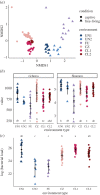Captive and urban environments are associated with distinct gut microbiota in deer mice (Peromyscus maniculatus)
- PMID: 36883780
- PMCID: PMC9994099
- DOI: 10.1098/rsbl.2022.0547
Captive and urban environments are associated with distinct gut microbiota in deer mice (Peromyscus maniculatus)
Abstract
Animals in captive and urban environments encounter evolutionarily novel conditions shaped by humans, such as altered diets, exposure to human-associated bacteria, and, potentially, medical interventions. Captive and urban environments have been demonstrated to affect gut microbial composition and diversity independently but have not yet been studied together. By sequencing the gut microbiota of deer mice living in laboratory, zoo, urban and natural settings, we sought to identify (i) whether captive deer mouse gut microbiota have similar composition regardless of husbandry conditions and (ii) whether captive and urban deer mice have similar gut microbial composition. We found that the gut microbiota of captive deer mice were distinct from those of free-living deer mice, indicating captivity has a consistent effect on the deer mouse microbiota regardless of location, lineage or husbandry conditions for a population. Additionally, the gut microbial composition, diversity and bacterial load of free-living urban mice were distinct from those of all other environment types. Together, these results indicate that gut microbiota associated with captivity and urbanization are likely not a shared response to increased exposure to humans but rather are shaped by environmental features intrinsic to captive and urban conditions.
Keywords: Peromyscus maniculatus; captivity; gut; microbiome; urbanization.
Figures


References
MeSH terms
Associated data
LinkOut - more resources
Full Text Sources

